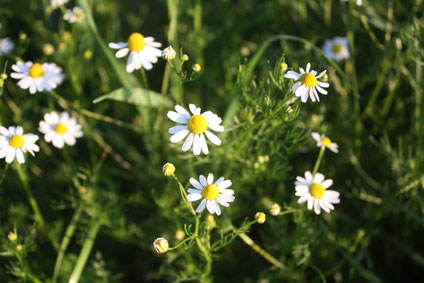
Let's pay another visit to Healer Keisha from Mercedes Lackey's novel Owlsight, whom we already met once before when discussing the healing qualities of wormwood. Keisha, as the village healer with a neat kitchen garden, has many healing herbs at hand. In the following snippet, she's treating a little boy who'd been in a fight with the village bully and is now sporting a bleeding nose and a black eye:
Her bit of advice had certainly silenced the child anyway; he seemed to be pondering it as they waited for his nose to stop bleeding. When Keisha judged that it had been long enough, she had him sit up and cautiously took the rag away from his nose. There was no further leakage, so she got up and mixed him a quick potion; chamomile for the ache in his eye and nose, mash-mallow and mint to counter any tummy upset from swallowing blood, and honey and allspice to make it into a treat.
So will this potion work as Keisha intends?
As for soothing an upset stomach - be it from swallowing too much blood or from the tension caused by the fight the boy has been through - the potion will certainly do that. Not only marshmallow and mint, but also chamomile, are all effective remedy for treating stomach upsets and other intestinal problems. Whether chamomile will also help with the boy's aching nose is doubtful, though it does have a calming effect on the psyche, so it might soothe away his upset - and with it, the pain.

There are two different plants called chamomile, either of which could be the herb in Keisha's potion: Roman chamomile (Chamaemelum nobile), and German chamomile (Matricaria chamomilla). Both plants contain essential oils, and both can used to alleviate inflammations of the intestinal tract and of the skin.
German chamomile (Matricaria chamomilla) is the better-researched herb, though even here, few clinical studies exist. In one study, the essential oil distilled from Matricaria chamomilla flowers
applied topically was found to be helpful to reduce the amount of
pain killers needed by patients suffering from knee osteoarthritis.
It seems likely that this effect stems from the oil's anti-inflammatory properties rather than a direct analgesic effect. It has been shown that chamomile's active ingredients penetrate
below the skin surface and can so reach deeper tissue to unfold its anti-inflammatory properties.
ESCOP has found German chamomile to be effective in treating skin infections, respiratory problems, and cramps and inflammatory diseases of the gastrointestinal
tract, but makes no mention of pain relief. But chamomile (both Roman and German) is said to have a slight sedative effect,
so the pain-killing effect Keisha expects her potion to have, as mentioned above, is most likely psychological rather than physical.

As I've also mentioned above, the potion will certainly be effective to soothe an upset stomach. Not only is chamomile said to work against stomach cramps, but so do the potion's other two ingredients.
Marshmallow (Althea officinalis) has proved effective to soothe inflamed mucus membranes such as the stomach lining, and (pepper-) mint calms the stomach's muscles and supports the digestive process.
Peppermint can also soothe a tension headache, thus making it a second prong in Keisha's approach to soothe away her young patient's hurts.
All three of the potion's ingredients are very versatile tools in Keisha's arsenal:
Marshmallow, in addition to soothing the stomach, can also be used to protect the mucosae of the pharynx and larynx, so Keisha might sometimes prescribe the herb for patients with a dry cough as well as for tummy upsets. Chamomile can calm anxieties and heal skin infections, and peppermint soothes away a headache and also has a calming effect.
*** Please note: This blog is not intended as medical advice. ***
Do not try this at home.
(Or at least, don't use any of the remedies described here this without consulting your physician first.)
